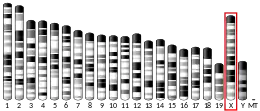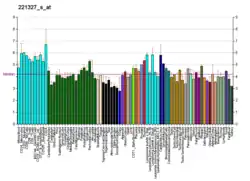| OPN1LW | |||||||||||||||||||||||||||||||||||||||||||||||||||
|---|---|---|---|---|---|---|---|---|---|---|---|---|---|---|---|---|---|---|---|---|---|---|---|---|---|---|---|---|---|---|---|---|---|---|---|---|---|---|---|---|---|---|---|---|---|---|---|---|---|---|---|
| |||||||||||||||||||||||||||||||||||||||||||||||||||
| Identifiers | |||||||||||||||||||||||||||||||||||||||||||||||||||
| Aliases | OPN1LW, CBBM, CBP, COD5, RCP, ROP, opsin 1 (cone pigments), long-wave-sensitive, opsin 1, long wave sensitive | ||||||||||||||||||||||||||||||||||||||||||||||||||
| External IDs | OMIM: 300822 MGI: 1097692 HomoloGene: 68064 GeneCards: OPN1LW | ||||||||||||||||||||||||||||||||||||||||||||||||||
| |||||||||||||||||||||||||||||||||||||||||||||||||||
| |||||||||||||||||||||||||||||||||||||||||||||||||||
| |||||||||||||||||||||||||||||||||||||||||||||||||||
| |||||||||||||||||||||||||||||||||||||||||||||||||||
| |||||||||||||||||||||||||||||||||||||||||||||||||||
| Wikidata | |||||||||||||||||||||||||||||||||||||||||||||||||||
| |||||||||||||||||||||||||||||||||||||||||||||||||||
OPN1LW is a gene on the X chromosome that encodes for long wave sensitive (LWS) opsin, or red cone photopigment.[5] It is responsible for perception of visible light in the yellow-green range on the visible spectrum (around 500-570nm).[6][7] The gene contains 6 exons with variability that induces shifts in the spectral range.[8] OPN1LW is subject to homologous recombination with OPN1MW, as the two have very similar sequences.[8] These recombinations can lead to various vision problems, such as red-green colourblindness and blue monochromacy.[9] The protein encoded is a G-protein coupled receptor with embedded 11-cis-retinal, whose light excitation causes a cis-trans conformational change that begins the process of chemical signalling to the brain.[10]
Gene
OPN1LW produces red-sensitive opsin, while its counterparts, OPN1MW and OPN1SW, produce green-sensitive and blue-sensitive opsin respectively.[7] OPN1LW and OPN1MW are on the X chromosome at position Xq28.[11] They are in a tandem array, composed of a single OPN1LW gene which is followed by one or more OPN1MW genes.[11] The locus control region (LCR; OPSIN-LCR) regulates expression of both genes, with only the OPN1LW gene and nearby adjacent OPN1MW genes being expressed and contributing to the colour vision phenotype.[11] The LCR can not reach further than the first or second OPN1MW genes in the array.[11] The slight difference in OPN1LW and OPN1MW absorption spectra is due to a handful of amino acid differences between the two highly similar genes.[8]
Exons
OPN1LW and OPN1MW both have six exons.[8] Amino acid dimorphisms on exon 5 at positions 277 and 285 are the most influential on the spectral differences observed between LWS and MWS pigments.[8] There are 3 amino acid changes on exon 5 for OPN1LW and OPN1MW that contribute to the spectral shift seen between their respective opsin: OPN1MW has phenylalanine at positions 277 and 309, and alanine at 285; OPN1LW have tyrosine at position 277 and 309, and threonine at position 285.[8] The identity of the amino acids at these positions in exon 5 is what determines the gene as being M class or L class.[8] On exon 3 at position 180 both genes can contain serine or alanine, but the presence of serine produces longer wavelength sensitivity, a consideration in the making of color-matching functions.[8][12] Exon 4 has two spectral tuning positions: 230 for isoleucine (longer peak wavelength) or threonine, and 233 for alanine (longer peak wavelength) or serine.[8]
Homologous recombination
The arrangement of OPN1LW and OPN1MW, as well as the high similarity of the two genes, allows for frequent recombination between the two.[8] Unequal recombination between female X chromosomes during meiosis is the main cause of the varying number of OPN1LW genes and OPN1MW genes among individuals, as well as being the cause of inherited colour vision deficiencies.[8] Recombination events usually begin with misalignment of an OPN1LW gene with an OPN1MW gene and are followed by a certain type of crossover, which can result in many different gene abnormalities. Crossover in regions between OPN1LW and OPN1MW genes can produce chromosome products with extra OPN1LW or OPN1MW genes on one chromosome and reduced OPN1LW or OPN1MW genes on the other chromosome.[8] If crossover occurs within the misaligned genes of OPN1LW and OPN1MW, then a new array will be produced on each chromosome consisting of only partial pieces of the two genes.[8] This would create colour vision deficiencies if either chromosome were passed onto a male offspring.[8]
Protein
The LWS type I opsin is a G-protein coupled receptor (GPCR) protein with embedded 11-cis retinal.[11] It is a transmembrane protein that has seven membrane domains, with the N-terminal being extracellular and the C-terminal being cytoplasmic.[5] The LWS pigment has a maximum absorption of about 564nm, with an absorption range of around 500-570 nm.[6] This opsin is known as the red opsin because it is the most sensitive to red light out of the three cone opsin types, not because its peak sensitivity is for red light.[7] The peak absorption of 564nm actually falls in the yellow-green section of the visible light spectrum.[7] When the protein comes in contact with light at a wavelength within its spectral range, the 11-cis-retinal chromophore becomes excited.[10] The amount of energy in the light breaks the pi bond that holds the chromophore in its cis configuration, which causes photoisomerization and a shift to the trans configuration.[10] This shift is what begins the chemical reaction sequence responsible for getting the LWS cone signal to the brain.[10]
Function
LWS opsin resides in disks of the outer segment of LWS cone cells, which mediate photopic vision along with MWS and SWS cones.[10][13] Cone representation in the retina is substantially smaller than rod representation, with the majority of cones localizing in the fovea.[13] When light within the LWS opsin spectral range reaches the retina, the 11-cis-retinal chromophore within the opsin protein becomes excited.[10] This excitation causes a conformational change in the protein and triggers a series of chemical reactions.[10] This reaction series passes from the LWS cone cells into horizontal cells, bipolar cells, amacrine cells, and finally ganglion cells before continuing to the brain via the optic nerve.[10] Ganglion cells compile the signal from the LWS cones with all other cone signals that occurred in response to the light that was seen, and pass the overall signal into the optic nerve.[6] The cones themselves do not process colour, it is the brain that decides what colour is being seen by the signal combination it receives from the ganglion cells.[10]
Evolutionary history
Before humans evolved to be a trichromatic species, our vision was dichromatic and consisted of only the OPN1LW and OPN1SW genes.[8] OPN1LW is thought to have undergone a duplication event that lead to an extra copy of the gene, which then evolved independently to become OPN1MW.[8] OPN1LW and OPN1MW share almost all of their DNA sequences, whereas OPN1LW and OPN1SW share less than half, suggesting that the long wave and medium wave genes diverged from each other much more recently than with OPN1SW.[11] The emergence of OPN1MW is directly associated with dichromacy evolving to trichromacy.[6] The presence of both LSW and MSW opsins improves colour recognition time, memorization for coloured objects, and distance-dependent discrimination, giving trichromatic organisms an evolutionary advantage over dichromatic organisms when searching for nutrient-rich food sources.[6] Cone pigments are the product of ancestral visual pigments, which consisted of only cone cells and no rod cells.[10] These ancestral cones evolved to become the cone cells we know today (LWS, MWS, SWS), as well as rod cells.[10]
Vision impairments
Red-green colour blindness
Many genetic changes of the OPN1LW and/or OPN1MW genes can cause red-green colourblindness.[9] The majority of these genetic changes involve recombination events between the highly similar genes of OPN1LW and OPN1MW, which can result in deletion of one or both of these genes.[9] Recombination can also result in the creation of many different OPN1LW and OPN1MW chimeras, which are genes that are similar to the original, but have different spectral properties.[14] Single base-pair changes in OPN1LW can also inflict red-green colourblindness, but this is uncommon.[9] The severity of vision loss in a red-green colourblind individual is influenced by the Ser180Ala polymorphism.[14]
Protanopia
Protanopia is caused by defective or total loss of the OPN1LW gene function, causing vision that is entirely dependent on OPN1MW and OPN1SW.[8] Affected individuals have dichromatic vision, with the inability to fully differentiate between green, yellow, and red colour.[8]
Protanomaly
Protanomaly occurs when a partially functional hybrid OPN1LW gene replaces the normal gene.[9] Opsins made from these hybrid genes have abnormal spectral shifts that impair colour perception for colours in the OPN1LW spectrum.[9] Protanomaly is one form of anomalous trichromacy.[8]
Blue cone monochromacy
Blue cone monochromacy is caused by a loss of function of both OPN1LW and OPN1MW.[9] This is commonly caused by mutations in the LCR, which would result in no expression of OPN1LW or OPN1MW.[9] With this visual impairment, the individual can only see colours in the spectrum for SWS opsins, which fall in the blue range of light.[9]
References
- 1 2 3 GRCh38: Ensembl release 89: ENSG00000102076 - Ensembl, May 2017
- 1 2 3 GRCm38: Ensembl release 89: ENSMUSG00000031394 - Ensembl, May 2017
- ↑ "Human PubMed Reference:". National Center for Biotechnology Information, U.S. National Library of Medicine.
- ↑ "Mouse PubMed Reference:". National Center for Biotechnology Information, U.S. National Library of Medicine.
- 1 2 "OPN1LW opsin 1, long wave sensitive [Homo sapiens (human)]". NCBI. Retrieved November 16, 2017.
- 1 2 3 4 5 Hofmann L, Palczewski K (2015). "Advances in understanding the molecular basis of the first steps in color vision". Progress in Retinal and Eye Research. 49: 46–66. doi:10.1016/j.preteyeres.2015.07.004. PMC 4651776. PMID 26187035.
- 1 2 3 4 Merbs SL, Nathans J (1992). "Absorption spectra of human cone pigments". Nature. 356 (6368): 433–5. Bibcode:1992Natur.356..433M. doi:10.1038/356433a0. PMID 1557124. S2CID 4238631.
- 1 2 3 4 5 6 7 8 9 10 11 12 13 14 15 16 17 18 19 Neitz J, Neitz M (2011). "The genetics of normal and defective color vision". Vision Research. 51 (7): 633–51. doi:10.1016/j.visres.2010.12.002. PMC 3075382. PMID 21167193.
- 1 2 3 4 5 6 7 8 9 "OPN1LW gene". U.S National Library of Medicine. Genetics Home Reference. Retrieved November 29, 2017.
- 1 2 3 4 5 6 7 8 9 10 11 Imamoto Y, Shichida Y (2014). "Cone visual pigments". Biochimica et Biophysica Acta (BBA) - Bioenergetics. 1837 (5): 664–73. doi:10.1016/j.bbabio.2013.08.009. PMID 24021171.
- 1 2 3 4 5 6 Deeb SS (2006). "Genetics of variation in human color vision and the retinal cone mosaic". Current Opinion in Genetics & Development. 16 (3): 301–7. doi:10.1016/j.gde.2006.04.002. PMID 16647849.
- ↑ "Molecular genetics and single-gene dichromats". cvrl.ioo.ucl.ac.uk.
- 1 2 "Rods and cones of the human eye". Ask a Biologist. ASU School of Life Sciences. 14 April 2010. Retrieved November 29, 2017.
- 1 2 Deeb, SS (2005). "The molecular basis of variation in human color vision". Clinical Genetics. 67 (5): 369–377. doi:10.1111/j.1399-0004.2004.00343.x. PMID 15811001. S2CID 24105079.
Further reading
- Applebury ML, Hargrave PA (1986). "Molecular biology of the visual pigments". Vision Res. 26 (12): 1881–95. doi:10.1016/0042-6989(86)90115-X. PMID 3303660. S2CID 34038855.
- Winderickx J, Lindsey DT, Sanocki E, Teller DY, Motulsky AG, Deeb SS (1992). "Polymorphism in red photopigment underlies variation in colour matching". Nature. 356 (6368): 431–3. Bibcode:1992Natur.356..431W. doi:10.1038/356431a0. PMID 1557123. S2CID 4362230.
- Dietrich A, Korn B, Poustka A (1992). "Completion of the physical map of Xq28: the location of the gene for L1CAM on the human X chromosome". Mamm. Genome. 3 (3): 168–72. doi:10.1007/BF00352462. PMID 1617223. S2CID 27038539.
- Arveiler B, Vincent A, Mandel JL (1989). "Toward a physical map of the Xq28 region in man: linking color vision, G6PD, and coagulation factor VIII genes to an X-Y homology region". Genomics. 4 (4): 460–71. doi:10.1016/0888-7543(89)90269-3. PMID 2501212.
- Nathans J, Thomas D, Hogness DS (1986). "Molecular genetics of human color vision: the genes encoding blue, green, and red pigments". Science. 232 (4747): 193–202. Bibcode:1986Sci...232..193N. CiteSeerX 10.1.1.461.5915. doi:10.1126/science.2937147. PMID 2937147.
- Adams MD, Kerlavage AR, Fleischmann RD, Fuldner RA, Bult CJ, Lee NH, Kirkness EF, Weinstock KG, Gocayne JD, White O (1995). "Initial assessment of human gene diversity and expression patterns based upon 83 million nucleotides of cDNA sequence" (PDF). Nature. 377 (6547 Suppl): 3–174. PMID 7566098.
- Li ZY, Kljavin IJ, Milam AH (1995). "Rod photoreceptor neurite sprouting in retinitis pigmentosa". J. Neurosci. 15 (8): 5429–38. doi:10.1523/JNEUROSCI.15-08-05429.1995. PMC 6577619. PMID 7643192.
- Chen J, Tucker CL, Woodford B, Szél A, Lem J, Gianella-Borradori A, Simon MI, Bogenmann E (1994). "The human blue opsin promoter directs transgene expression in short-wave cones and bipolar cells in the mouse retina". Proc. Natl. Acad. Sci. U.S.A. 91 (7): 2611–5. Bibcode:1994PNAS...91.2611C. doi:10.1073/pnas.91.7.2611. PMC 43419. PMID 8146162.
- Nathans J, Maumenee IH, Zrenner E, Sadowski B, Sharpe LT, Lewis RA, Hansen E, Rosenberg T, Schwartz M, Heckenlively JR (1993). "Genetic heterogeneity among blue-cone monochromats". Am. J. Hum. Genet. 53 (5): 987–1000. PMC 1682301. PMID 8213841.
- Ladekjaer-Mikkelsen AS, Rosenberg T, Jørgensen AL (1996). "A new mechanism in blue cone monochromatism". Hum. Genet. 98 (4): 403–8. doi:10.1007/s004390050229. PMID 8792812. S2CID 11799731.
- Ferreira PA, Nakayama TA, Pak WL, Travis GH (1996). "Cyclophilin-related protein RanBP2 acts as chaperone for red/green opsin". Nature. 383 (6601): 637–40. Bibcode:1996Natur.383..637F. doi:10.1038/383637a0. PMID 8857542. S2CID 4304490.
- Voegel JJ, Heine MJ, Tini M, Vivat V, Chambon P, Gronemeyer H (1998). "The coactivator TIF2 contains three nuclear receptor-binding motifs and mediates transactivation through CBP binding-dependent and -independent pathways". EMBO J. 17 (2): 507–19. doi:10.1093/emboj/17.2.507. PMC 1170401. PMID 9430642.
- Zhao Z, Hewett-Emmett D, Li WH (1998). "Frequent gene conversion between human red and green opsin genes". J. Mol. Evol. 46 (4): 494–6. Bibcode:1998JMolE..46..494Z. doi:10.1007/PL00013147. PMID 9541545. S2CID 17082136.
- Nakayama TA, Zhang W, Cowan A, Kung M (1998). "Mutagenesis studies of human red opsin: trp-281 is essential for proper folding and protein-retinal interactions". Biochemistry. 37 (50): 17487–94. doi:10.1021/bi982077u. PMID 9860863.
- John SK, Smith JE, Aguirre GD, Milam AH (2000). "Loss of cone molecular markers in rhodopsin-mutant human retinas with retinitis pigmentosa". Mol. Vis. 6: 204–15. PMID 11063754.
- Ueyama H, Kuwayama S, Imai H, Tanabe S, Oda S, Nishida Y, Wada A, Shichida Y, Yamade S (2002). "Novel missense mutations in red/green opsin genes in congenital color-vision deficiencies". Biochem. Biophys. Res. Commun. 294 (2): 205–9. doi:10.1016/S0006-291X(02)00458-8. PMID 12051694.
- Fitzgerald KA, Rowe DC, Barnes BJ, Caffrey DR, Visintin A, Latz E, Monks B, Pitha PM, Golenbock DT (2003). "LPS-TLR4 signaling to IRF-3/7 and NF-kappaB involves the toll adapters TRAM and TRIF". J. Exp. Med. 198 (7): 1043–55. doi:10.1084/jem.20031023. PMC 2194210. PMID 14517278.
- Long J, Wang G, Matsuura I, He D, Liu F (2004). "Activation of Smad transcriptional activity by protein inhibitor of activated STAT3 (PIAS3)". Proc. Natl. Acad. Sci. U.S.A. 101 (1): 99–104. Bibcode:2004PNAS..101...99L. doi:10.1073/pnas.0307598100. PMC 314145. PMID 14691252.




